skip to main |
skip to sidebar
Events of Friday, 13th October 2017
Early in the morning, 'Road to Mandalay' slipped away from her overnight anchorage and continued down stream to Bagan. After an enjoyable breakfast, I watched as the mysterious silhouette of Mount Popa slipped by on our port side. Mount Popa is an extinct volcano with a collapsed caldera, famous as the home of the 37 Nats, spirits widely believed in by both Buddhists and non-Buddhists. There's a brief introduction to Nats in Wikipedia here.
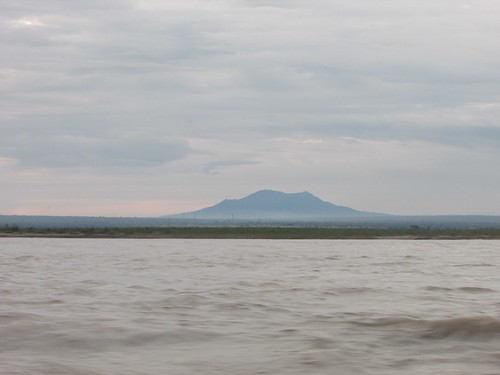
Cruising to Bagan: Mount Popa, viewed from the Ayeyarwaddy.
By nine o'clock, the ship was once again anchoring mid-stream, opposite the private 'Belmond' landing stage at Bagan. Logistics staff and a motor boat were waiting to bring the guests ashore at 9.30 a.m.
Once on land, we were faced with the steep, zig-zag climb up to the 'Belmond' car park.
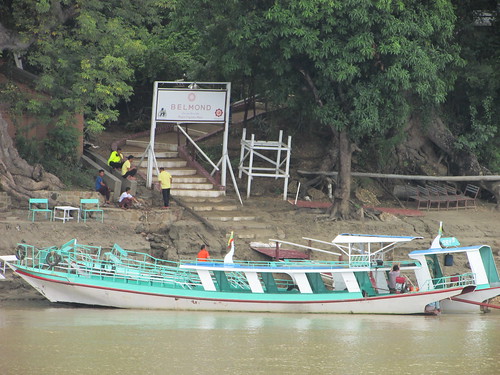
The private 'Belmond' landing stage at Bagan.
Guests had four choices for the morning tour. Two small coaches and a car were ready to take three of the groups and a series of modern mountain bicyles (with safety helmets) were waiting for the 'Bagan by Bicycle' guests. A far cry from my first bicycle ride at Bagan, back in 2008, which I described in the post here. That bike ride serves as an example of how trivial events can have long-term effects. A minor incident at the beginning of that ride (I fell off) introduced me to Doctor Hla Tun and, as a result, I have ever since tried to support the educational and charitable work he organises in Myanmar.

The 'Bagan by Bicycle' guests about to set off.
Doctor Hla Tun had come ashore with the guests but he immediately set off on the short walk to the adjacent Bagan Medical Clinic where he would start his consultations which would continue until 11.0 p.m. Once I'd watched the various groups of guests depart to explore Bagan, I followed Doctor Hla Tun to the Clinic. Both the Belmond car park and the Bagan Medical Clinic are within the Compound of Bagan Monastery.
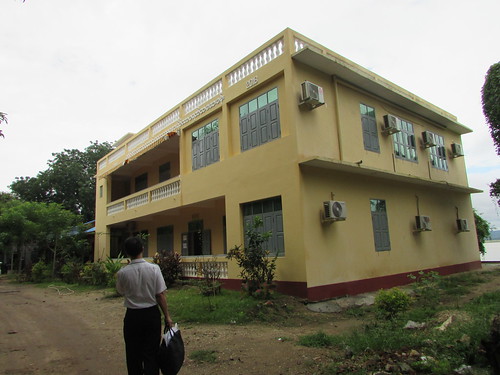
Bagan Medical Clinic, Friday: Doctor Hla Tun passes the 2-storey clinic building on his way to his consulting room.
The original clinic building, opened in 2011 is still the 'centre of operations' as it houses patient registration and the dispensary, in addition to consulting rooms and 'messing' facilities for the staff. The monk who has supervised the activities of the clinic since its opening greeted me and showed me the patient registrations so far - 188.
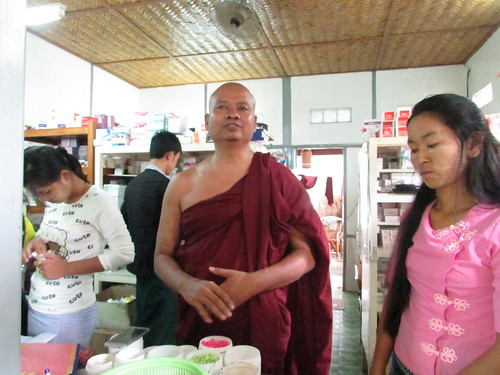
Bagan Medical Clinic, Friday: The monk who has supervised the activities of the clinic since its opening.
Doctor Hla Tun appeared and it was decided that it was an appropriate moment for a 'group shot' with the staff present.

Bagan Medical Clinic, Friday: The 'group shot'.
I then accompanied Doctor Hla Tun to his consulting room where I met Doctor Jyn Aung Thet, a charming, Burmese-born doctor from Wisconsin, U.S.A. who, now retired, returns to Burma and frequently carries out consultations at the clinic.
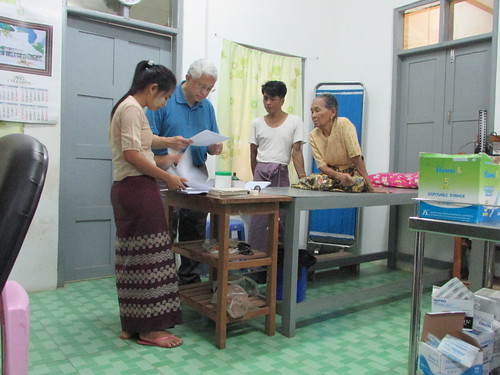
Bagan Medical Clinic, Friday: Doctor Jyn Aung Thet carries out a consultation.
Doctor Jyn Aung Thet was accompanied by his cousin, a radiologist, and she was studying the Fukuda UF-850XTD full digital Ultrasound System, recently-installed in the 2-storey building.
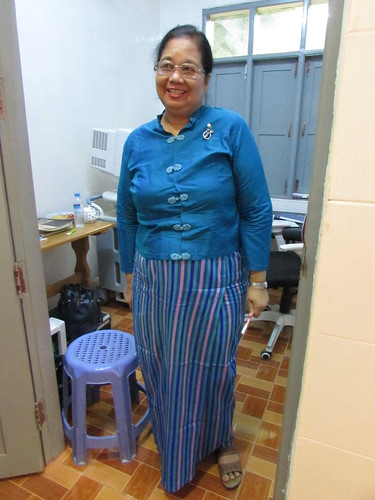
Bagan Medical Clinic, Friday: Doctor Jyn Aung Thet's cousin
I then carried out my customary tour of the now-extensive clinic site, looking for developments since my last visit in April 2017 (which was described in the post here). The Dentist's room on the ground floor of the 2-storey building was much as I'd seen it in April.
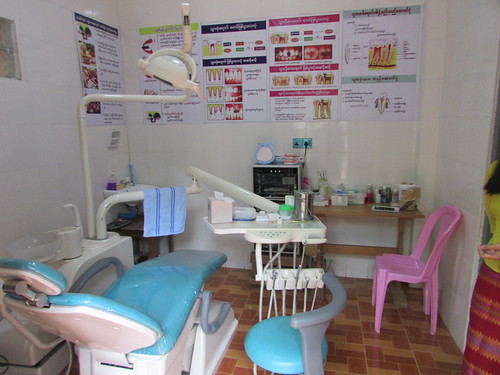
Bagan Medical Clinic, Friday: The well-equipped Dentist's room in the 2-storey building.
The 2-storey building has rooms for two Operating Theatres on the upper floor. The first room now has the specialist equipment installed but staff training and Government approval has to be completed before it can be brought into use.
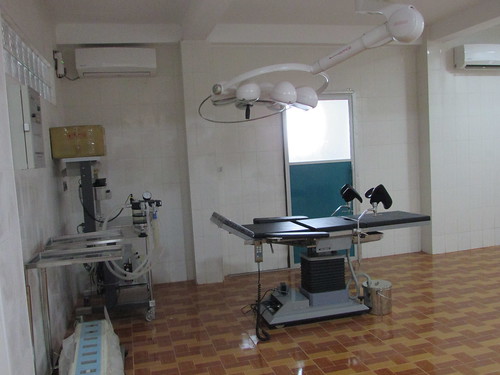
Bagan Medical Clinic, Friday: Equipped Operating Theatre in the 2-storey building.
Nearby is a the essential Large Medical Autoclave. This allows equipment used in surgical operations to be sterilised. There's a Wikipedia article on autoclaves here.
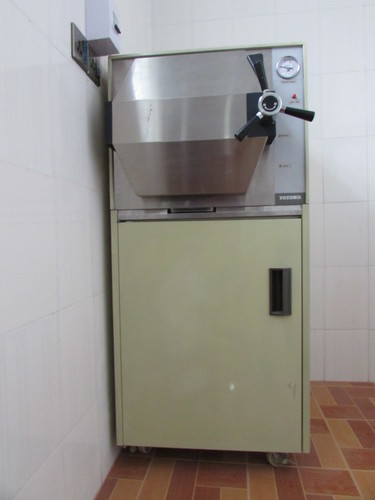
Bagan Medical Clinic, Friday: Large Medical Autoclave.
The mobile X-ray equipment I noted on my last visit was still awaiting the delivery of associated equipment prior to commissioning.
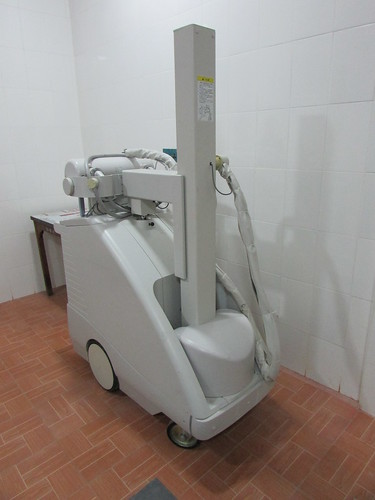
Bagan Medical Clinic, Friday: Toshiba Mobile X-ray Machine.
I moved to the nearby Hospital Building which had been very much a building site on my previous visit. The upper floor is now structurally complete with railings on the balcony.
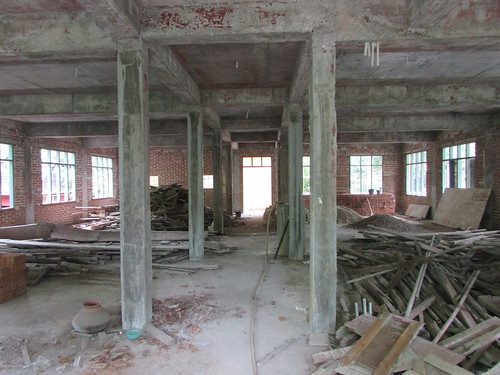
Bagan Medical Clinic, Friday: The upper floor of the Hospital Building is now structurally complete.
The building is now painted outside and the two wards on the ground floor have had tiled floors and walls finished. Most electrics, including oscillating ceiling fans, are complete. White-painted patient beds are temporarily stored in the wards.
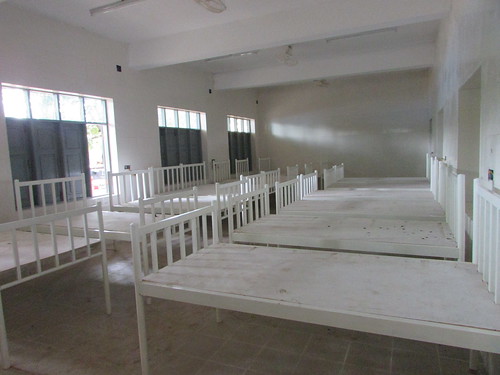
Bagan Medical Clinic, Friday: One of two wards in the Hospital Building almost complete and temporarily storing beds.
Next, I examined the new standby generator - a Caterpillar DE65E0 packaged unit which has been provided with a smart-looking building with a blue roof. This is another addition since my previous visit just a few months earlier.

Bagan Medical Clinic, Friday: The Standby Electricity Generator in its blue-roofed building.
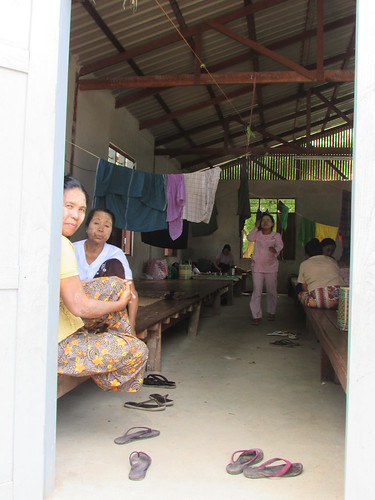
Bagan Medical Clinic, Friday: Waiting patients in the Dormitory Building.

Bagan Medical Clinic, Friday: On a 'Clinic Day' all the stalls lining the approach to the Clinic are open for business.
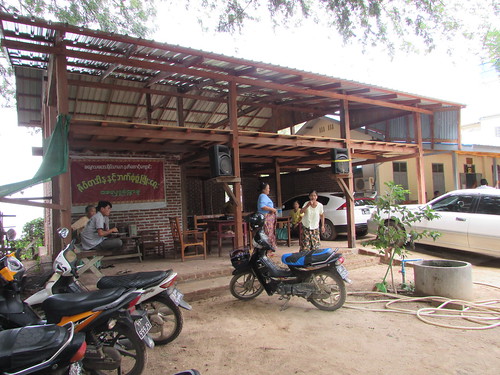
Bagan Medical Clinic, Friday: Another substantial building is under construction in between the First Clinic Building and Doctor Hla Tun's consulting room.
All the clinic buildings are on monastery land and operate under the authority of the Abbott of the monastery. The monastery and monastic school operate from a series of fairly recent buildings dotted around the compound. But there is an older, wooden monastery building on the site, no longer in regular use. This is Nat Taung Kyaung, around 200 years old and quite famous for its carving. Since 2008, I've admired the building without studying it closely so I determined to make a photographic record of the outside at least. Being well away from the main tourist routes through Bagan, this building has become something of a 'hidden gem', although it has an extensive review in the scholarly publication 'Splendour in Wood'.

Nat-Taung Kyaung Monastery, Bagan
The detail of the carving remains impressive and compares with better-known Yoke-Sone-Kyaung at Salay, described in my post here.

Nat-Taung Kyaung Monastery, Bagan: Detail of wood carving.
The temperature had risen during the morning to around 32 Celsius - enough to leave me dripping with perspiration and exhausted. Knowing that the guests from the ship would have completed their morning tour and be returning to the ship for lunch, I made my way to the Belmond landing place and was quickly returned to the cool quiet of 'Road to Mandalay' where I enjoyed a splendid lunch. The guests went ashore again a 3.30 p.m. for a second exploration in "wonderful Bagan".

B-RTM: Bagan, Second trip ashore 15:30 Friday.
I accompanied the guests on the boat and then rejoined Doctor Hla Tun in Bagan Medical Clinic. Later in the afternoon, Doctor Hla Tun received some training in the interpretation of ultrsound images. Whilst the Doctor continued with his consultations until the last boat back to the ship at 11.0 p.m., I returned in time for a relaxed dinner, followed by a traditional marionette show in the lounge. I managed to do a little work on my computer before retiring.

Bagan Medical Clinic, Friday: Doctor Hla Tun examining images on the Ultrasound equipment.
Related posts on this website
This is one of a series of posts describing my 12th visit to Myanmar. The post Starting out is the first post in the series.
Clicking on the 'Next report' link displays the post describing the next events. In this way, you may read about the trip in sequence.
Next report
Alternately, clicking on the 'All my Burma-2017(2) reports' link displays all the posts on this trip in reverse date-of-posting order.
All my Burma-2017(2) reports.
My photograph albums
Where necessary, clicking on an image above will display an 'uncropped' view or, alternately, pictures may be selected, viewed or downloaded, in various sizes, from the albums listed:-
'Road to Mandalay': October 2017.
B-RTM: Cruising to Bagan.
Bagan Medical Clinic, Friday.
Nat-Taung Kyaung Monastery, Bagan.
Events of Thursday, 12th October 2017
I'd slept soundly in the luxury of the 'Road to Mandalay' river ship and was gently awoken by early morning tea, delivered to my cabin at the appointed time.
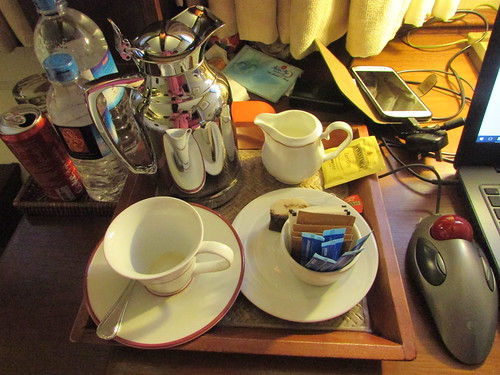
'Road to Mandalay': Early morning tea.
I arose and took a leisurely breakfast in the spacious restaurant. The ship quietly slipped away from its mooring at Shwe Kyet Yet, turned, and gently made its way down stream, passing first under the massive Yadanabon Highway Bridge (opened 2008) and then the Ava Bridge. The original Ava Bridge was destroyed in World War II and rebuilt in 1953, providing a single line railway flanked by two carriageways for road traffic. We were then abeam historic Ava and a variety of shore tours were on offer to guests. Doctor Hla Tun had suggested that I take one of these, so I elected for 'Ava by Horse and Cart'. The ship swung around and moored midstream whist a chartered motor boat came from the shore to ferry the guests to the landing point.

Ava Tour by horse and cart: View of 'Road to Mandalay' as we were ferried ashore.
There was a sizeable 'welcoming committee' at the landing point, including a number of vendors selling souvenirs but there was also also a row of two-wheeled carts harnessed to willing horses. Some of the guests had decided, instead, to tour Ava by bicycle.
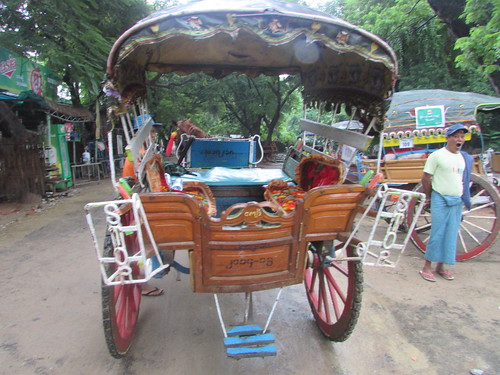
Ava Tour by horse and cart: I rather liked the 'STOP' signs, made out of welded steel rod.
The guests were quickly allocated to the various vehicles and we set off, at a gentle trot. Our first visit was to the Maha Aung Mye Bom San Monastery - 'The Brick Monastery'. This was built by Nanmadaw Me Nu, Chief Queen of King Bagyidaw in 1822, during the Konbaung Period when monasteries were generally wooden. In brick and stucco, its style copies the traditional wooden designs. It was damaged during an earthquake in 1838 and restored by the daughter of the Founder, Sinphyumashin, who was one of King Mindon's Queens.
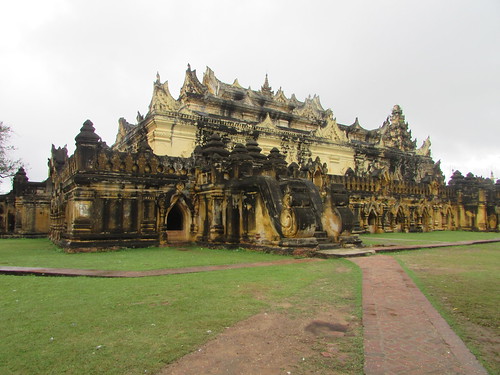
Ava Tour by horse and cart: The Maha Aung Mye Bom San Monastery - 'The Brick Monastery'.
Our transport then took us to the Bagaya Monastery, built in 1834 in teak using 267 teak posts. The largest post is 60 feet tall with a circumference of 9 feet. The structure has a plan 188 feet long and 103 feet wide and houses a number of important cultural objects.
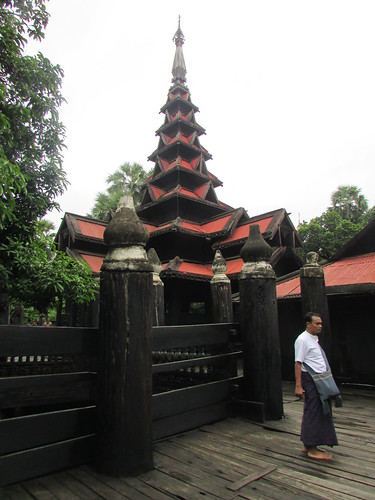
Ava Tour by horse and cart: Bagaya Monastery and one of the 'Road to Mandalay' guides.
After our visit to the monastery, our horse and cart returned us along generally quiet roads to the landing point, where the motor boat was waiting to take us back to 'Road to Mandalay'. Once all the guests were back on board, 'Road to Mandalay' weighed anchor and continued downstream on her trip to Bagan.
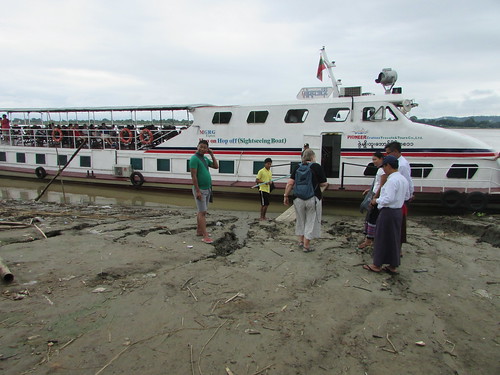
Ava Tour by horse and cart: The chartered motor boat ready to return the guests to the ship.
At 11.30 a.m. Doctor Hla Tun gave an illustrated presentation in the Observation Lounge on the Social Activities carried out by 'Road to Mandalay' and Belmond in Myanmar. Originally, this was in providing educational support to schools. There are a number of posts in this blog detailing this work: you can find them here. Initially, some medical support was given by occasional 'mobile clinics' but, since 2011, regular consultations have been provided at Bagan Medical Clinic. Supported by overseas and local donations, the clinic has rapidly expanded and this work is also documented in this blog at here. On 2nd May 2008, Cyclone Nargis struck the delta region of Myanmar (formerly Burma) causing major flooding and terrible damage. Doctor Hla Tun responded by organising relief to the more remote areas of the Delta Area and making over 50 trips to run temporary medical clinics. This work is summarised in a number of posts included in the group Charity Work.
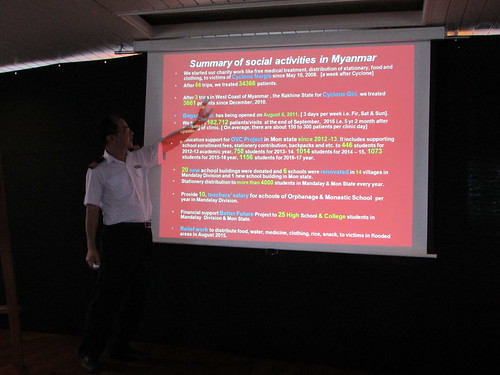
Dr. Hla Tun's Presentation
After lunch, a variety of ship-board activities were available for the guests but I worked in my cabin until dinner. The ship moored mid-channel for the night. After dinner, there was a 'Surprise on the River' which I'd seen before a couple of times. For instance, in 2009 I wrote:-
The evening terminated in a ‘Surprise on the River’. Around 2,000 tiny rafts, each carrying a lighted candle and some fitted with a coloured paper screen to produce varied colours, floated down the river towards us from upstream where, hidden in the darkness, local villagers retained by ‘Road to Mandalay’ lit and launched the craft from a number of boats positioned across the river. The emotion as these lights came towards us, embraced the ship some passing on the one side some on the other then disappearing into the darkness downstream, is hard to describe. As the passengers made their way to bed (or to the Piano Bar for late-night drinks), there were many moist eyes at the beauty of the effect.
I still found it a spectacular and moving experience. Then, I retired to bed. The next morning, we would sail to Bagan and, whilst the guests explored the wonders of the temples of Bagan I intended to spens the day around Bagan Medical Clinic.
Related posts on this website
This is one of a series of posts describing my 12th visit to Myanmar. The post Starting out is the first post in the series.
Clicking on the 'Next report' link displays the post describing the next events. In this way, you may read about the trip in sequence.
Next report
Alternately, clicking on the 'All my Burma-2017(2) reports' link displays all the posts on this trip in reverse date-of-posting order.
All my Burma-2017(2) reports.
My photograph albums
Where necessary, clicking on an image above will display an 'uncropped' view or, alternately, pictures may be selected, viewed or downloaded, in various sizes, from the albums listed:-
'Road to Mandalay': October 2017.
Ava Tour by horse and cart.
Dr. Hla Tun's Presentation.
On my first visit to Yangon in 2008, I discovered the 'Circle Line', a double-track ring railway around the city which I travelled on, triggering an enduring fascination with the railways in Myanmar.
So, you may imagine, I was intrigued when I discovered that Mandalay, too, had a Circle Line. It seemed clear enough from the map - leave Mandalay heading south, branch left onto the Lashio line at Myo Haung, branch left again at Thoe Gyan and travel north through the eastern part of the city, turn west then south so as to join the Madaya line at Owe Boe and continue so as to enter Mandalay station from the north.
The line to Madaya had originally been a 2 foot 6 inch gauge light railway (described in the post here) but, after that railway's closure in 1927, the line was rebuilt to metre gauge and connected to the main station at Mandalay. This would involve passing through the grounds of Mandalay Palace and somehow crossing its moat (twice) which troubled me since I'd seen no railway bridges over the moat and the alternative of diving into a tunnel seemed problematic.
To add to my puzzlement, nobody seemed to understand my queries about the times of trains on the Circle Line - maybe there was one a day, I was told, but it was all uncertain.
Myanma Railways publish a map of the lines in Mandalay Division and that, too, seemed to confirm the existence of the Circle Line.

Route Map of Mandalay Division (Myanma Railways).
In 2014, I looked from Mandalay station towards the tracks leading north without solving the riddle.
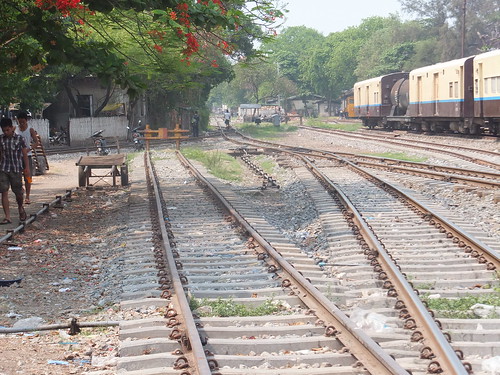
Mandalay Station, showing the tracks to the north in 2014.
In 2015, I made a more serious attempt to clarify matters. Leaving the station, I walked south on 78th Street, crossed the railway by 34th Street at a frequently-used crossing point for pedestrians involving stepping over the rails, headed north outside the boundary wall of the railway, through an area known, I believe, as Tayoke Tan Market or 79th Street, turned right to walk east on 26th Street (next to the South Palace Moat) for a few yards, before taking an alley to the west of 78th Street where the was no railway boundary wall and I had a good view of the shunting in progress and secured a number of pictures. Here, I found a stop block at the northern limit which suggested that the line northwards no longer existed.
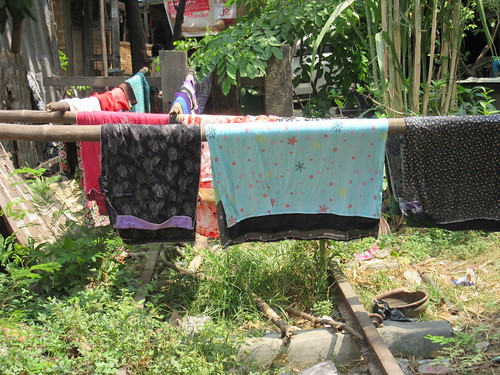
Stop block at the northern limit of the line on alley to west of 78th Street at the north end of Mandalay Station.
It was not until late 2017 that my friend took me to the fascinating open-air market at Tha Ye Ze which takes place on the approach tracks to Tha Ye Ze Station. I described my amazement as a train arrived and ran round its train, temporarily displacing the traders and most of their vegetables, in the post here. To the south of Tha Ye Ze Station, there is a short headshunt allowing the locomotive to run round and then the line stops, just short of 12th Street (next to the North Palace Moat).
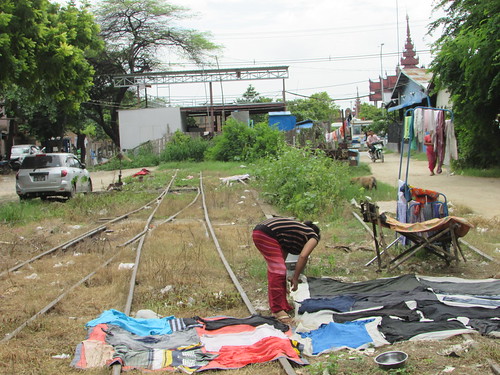
Tha Ye Ze (Madaya Line) looking south showing the end of the line. The steel frame of a new building is on 12th Street. Once the locomotive has run round, the track is covered with washing being dried.
On the late 2017 trip, I'd also been told that there was one departure a day from Mandalay to Madaya, at 5.00 a.m. Slowly, realisation dawned - there was, now, no 'Circular Railway'. The 5.00 a.m. train was, almost certainly, the train I'd seen at Tha Ye Ze around 11.00 o'clock. Having left Mandalay heading south, it had branched left onto the Lashio line at Myo Haung, branched left again at Thoe Gyan and travelled north through the eastern part of the city, before turning through 180 degrees so as to join the Madaya line at Owe Boe, finally continuing to the present terminus, Tha Ye Ze. Having run round its train, it could then perform trips to Madaya, as required, before returning to Mandalay by reversing the procedure adopted to first reach Tha Ye Ze in the morning.
But had there ever been a Circle Line? 'Oh yes', said my friend, a long-term resident in Mandalay. South of Tha Ye Ze, there had been a level crossing on 12th Street, a bridge over the Palace Moat then the line pierced the Palace Wall, passed across the Palace grounds, pierced the walls again, crossed the Moat on another bridge and 26th Street on a level crossing before entering the north end of Mandalay station. as I'd anticipated. But Mandalay Palace grounds are a Military area so, some time in the 1990s, the line through the Palace grounds was severed, to improve security.
We drove along 12th Street, so that I could photograph the part of the Palace Walls which the railway passed through and, indeed alterations to the brickwork are apparent.
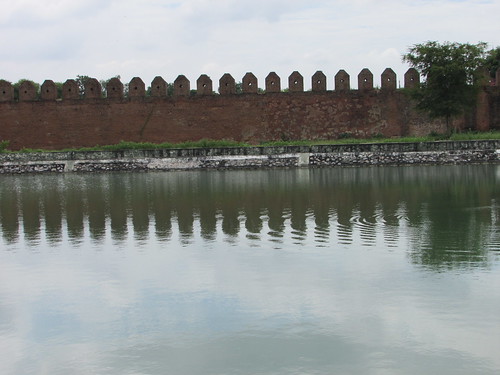
View of Palace Wall to the south of 12th Street. Note the alterations to the brickwork on the right of the picture.
I was pleased that I had 'solved the riddle'. However, only a few days later, I discovered that a far more detailed account of this history will appear in my friend Dieter Hettler's eagerly-awaited book "Railways of Myanmar"!
Related posts on this website
The Madaya Light Railway.
Mandalay Area Railways.
Alternately, clicking on the 'All my Myanma Railways Posts' displays all my posts describing railways in Myanmar in reverse date-of-posting order.
All my Myanma Railways Posts.
My photograph albums
Where necessary, clicking on an image above will display an 'uncropped' view or, alternately, pictures may be selected, viewed or downloaded, in various sizes, from the albums listed:-
Mandalay's railways.
Mandalay's railways, 2015.
Owe Boe Station, Mandalay.
MR: Tha Ye Ze.
Myo Haung Station, 2013.
MR: Myo Haung Signal Cabin.
Events of Wednesday, 11th October 2017
In the morning my friend Ko Hlaing came to my hotel with Sandy, his 8-year old daughter. We travelled by a taxi he'd engaged to look at the unusual open-air market at Tha Ye Ze. Vegetable vendors were everywhere, squatting on the ground with their produce. I could just make out two parallel and apparently abandoned railway tracks running through the site, underneath the impromptu market stalls.
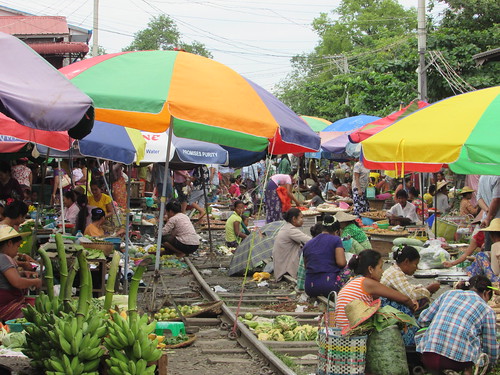
Tha Ye Ze (Madaya Line): The Market in full swing.
But, after about ten minutes, some of the traders reluctantly started to move their produce to one side, clearing a narrow pathway where the one set of rails lay. Looking down the track, I could see a 900 horse power diesel electric locomotive and its train slowly approaching.

Tha Ye Ze (Madaya Line): With most of the produce removed from the line, DD.901 arrives with its train.
The train passed through the market and came to a halt a few yards further on at Tha Ye Ze station. The locomotive needed to run round its train, so the traders then had to clear the second line to let the locomotive pass and finally allow the locomotive to traverse the market a third time to couple onto its train ready for the next working. The market traders carried on selling their produce as if nothing had happened. I didn't discover the time of the next service to Madaya but, having shut down the diesel engine, the smiling Driver let me climb up and examine the cab.
This market visit was the key to my gaining an understanding of the history of Mandalay's 'Circle Line' railway, which I discuss in the post here.
Sandy wasn't too well that day so we drove to the family shop in 'The Street of the Marble Carvers' where we left her to relax.

Sandy and Ko Hlaing.
Ko Hlaing and I continued by car to Myo Haung station on the main Mandalay - Yangon line. The rest of the day was spent in the signal cabin there, studying the equipment and working arrangements and, occasionally, making a few lever movements under supervision.
Train movements to the next Block Station are authorised by a Paper Line Clear Form, carried to the driver by a 'runner'.
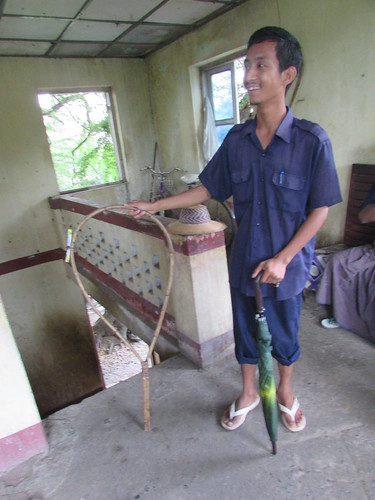
Myo Haung Signal Cabin: A railwayman displays the cane hoop with the vital rolled-up Paper Line Clear Form attached. This form is issued by the Controller and, when received by the driver, authorises the train's movement.
Myo Haung has an interlocked lever frame. All signals are searchlight or position-light types. Points are a mixture of electrically-operated and mechanically operated.
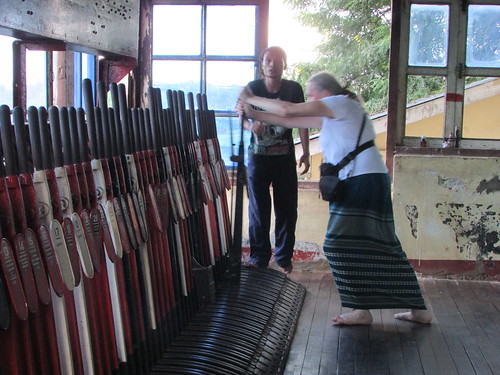
Myo Haung Signal Cabin: Jan replaces a point lever, watched by the signalman. Bare feet show respect for the location.
I was allowed to clear the signals for the afternoon express from Mandalay to Yangon - a new, Chinese-built Bo-Bo-Bo locomotive at the head of modern, Chinese-built coaches.
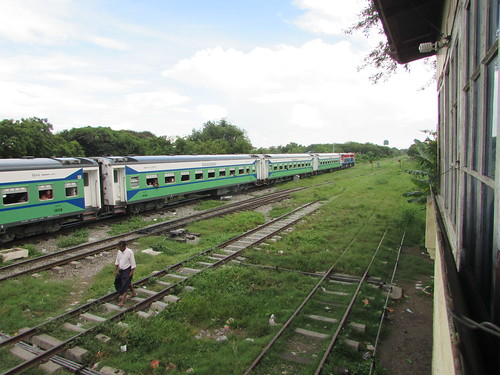
MR: Myo Haung Signal Cabin: The afternoon express from Mandalay to Yangon - Chinese-built locomotive and modern, Chinese-built coaches.
What a great experience! So, how do you follow that? The taxi took Ko Hlaing and me to Shwe Kyet Yet Jetty, where the 'Road to Mandalay' river cruise ship has private moorings and facilities for re-supplying the ship. The ship was moored against the bank so I was able to board using a rather smart gangway to find the Hotel Manager, Marie, waiting to greet me and introduce me to the ship's officers - the Captain, Doctor Hla Tun and the Chief Engineer. Although I'd not travelled on the ship for a number of years, there were many familiar, smiling faces so it was a very pleasant 'homecoming' for me. After settling into my comforable cabin, I enjoyed an excellent dinner with Doctor Hla Tun in the ship's spacious restaurant.
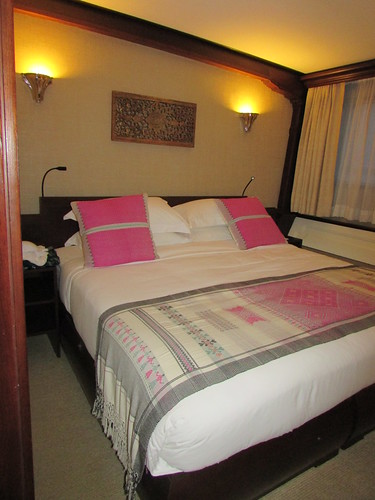
'Road to Mandalay', 2017.
Related posts on this website
This is one of a series of posts describing my 12th visit to Myanmar. The post Starting out is the first post in the series.
Clicking on the 'Next report' link displays the post describing the next events. In this way, you may read about the trip in sequence.
Next report.
Alternately, clicking on the 'All my Burma-2017(2) reports' link displays all the posts on this trip in reverse date-of-posting order.
All my Burma-2017(2) reports.
My photograph albums
Where necessary, clicking on an image above will display an 'uncropped' view or, alternately, pictures may be selected, viewed or downloaded, in various sizes, from the albums listed:-
Rupar Mandalar Hotel.
MR: Tha Ye Ze.
MR: Myo Haung Signal Cabin.
'Road to Mandalay': October 2017.
[Minor changes, pictures added 26-Oct-2017]
Events of Tuesday 10th October 2017
We'd arranged that my friend Htein Lin, his wife and two daughters would visit me at my hotel for a trip out. They arrived a little before 8.00 a.m. and we all sat on the Poolside Terrace at the hotel and enjoyed a simple breakfast together.
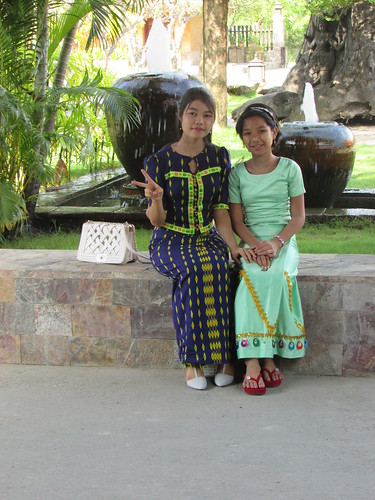
Htein Lin's Daughters at Rupar Mandalar Hotel.
Until recently, Htein Lin was a locomotive driver based at Mohnyin locomotive depot. We had first met in 2012 when he was the driver of the 'Road to Mandalay' special train from Katha to Naba. That day is described in the post here. Before becoming a driver, Htein Lin had followed his father in working at the Railway Workshops in Myitnge, a few miles south of Mandalay. Recently, he had accepted a supervisory position in the New Coach Construction Factory currently being built at Myitnge and, only a few days before our meeting, had brought his family and furniture back from Mohnyin to Myitnge where family members still live. At the same time, his elder daughter was about to start a degree course in Mathematics at Mandalay University.
So you may imagine that there were many things to talk about but, inevitably, railways in Britain and Myanmar featured heavily. Htein Lin had arranged for me to have a tour of the existing coach workshops at Myitnge and the new factory under construction which should open in 2018 so we had to break off to travel to Myitnge.
My friend had arranged the use of an official railway car (a RAV4) and driver so we climbed aboard and set off into Mandalay's heavy traffic. Being a railway vehicle, the windscreen bore an official 'sticker'. I realised the advantage that this conferred when we approached the modern road toll station south of the city, for we passed through unmolested. I've enjoyed the same happy experience when engaged on charitable work travelling in a Monastery car.
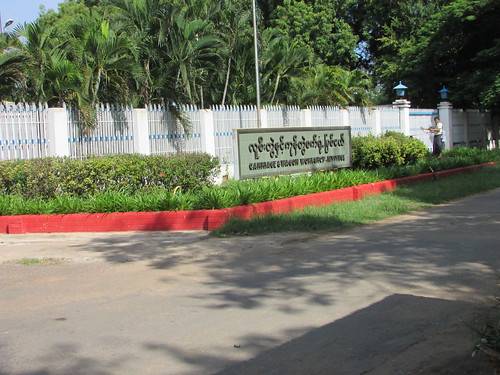
Myitnge Carriage and Wagon Workshop: Main entrance.
On arrival at the Carriage and Wagon Workshop, we parked outside the main entrance and, after a short meeting with the General Manager, we started a walking tour of the extensive workshops, built by the British.
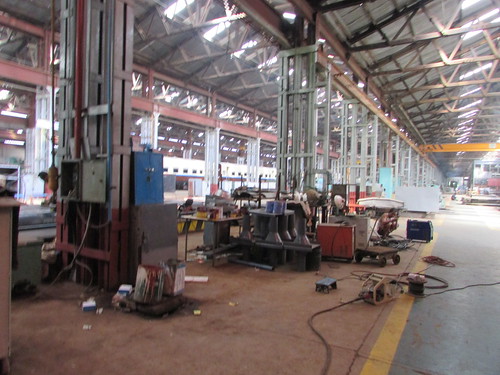
Myitnge Carriage and Wagon Workshop: General view of carriage workshop.
Each production area was neatly laid out, with painted walkways and carefully signed (in English) showing the work carried out. We looked and both major repairs to coaches and New Construction of existing designs. I found it most impressive.
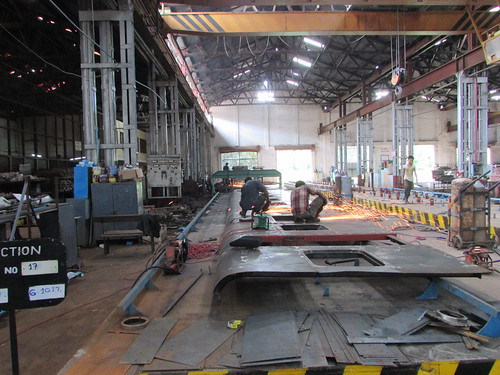
Myitnge Carriage and Wagon Workshop: Welded sides for new coaches being fabricated.
However, in an effort to improve levels of passenger comfort, Myanmar has concluded an agreement with China regarding a 'Concession Factory' to construct large numbers of new coaches of Chinese design. I toured the huge new steel-framed industrial buildings being provided for this project. These buildings are in an advanced stage of construction and production of the new coaches, using air suspension to give better ride characteristics, is expected to start in 2018.
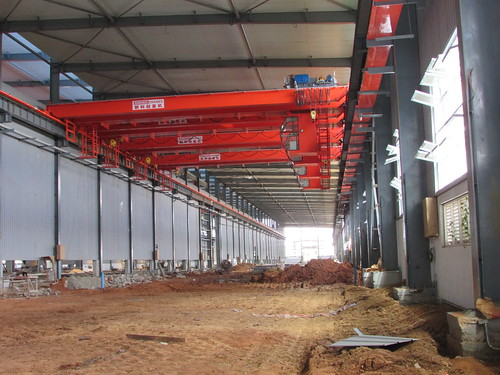
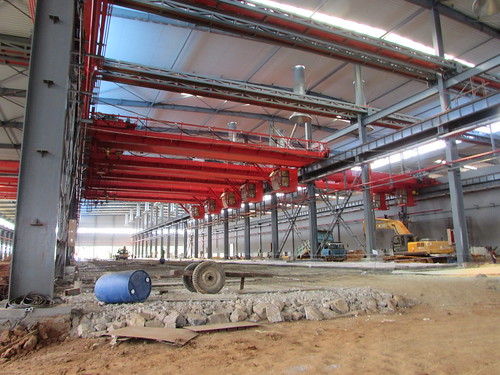
Myitnge Carriage and Wagon Workshop: New factory for producing coaches with air-suspension.
Following the tour of the new factory, we visited Htein Lin's Parents at their home in Myitnge.

Htein Lin and his Parents.
Nearby, we met up with Htein Lin's family at a relative's home in Myitnge, where I had an excellent lunch exactly to my rather limited taste in Myanmar food.
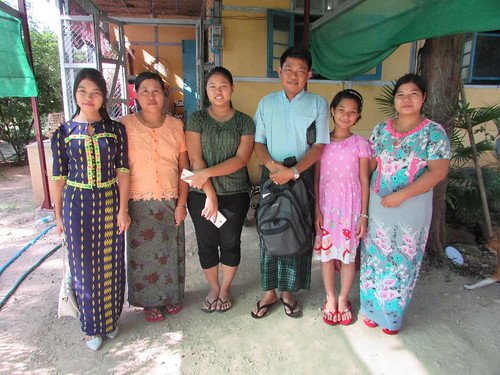
Htein Lin and Family at Myitnge.
We then went to see a modern pagoda which, unusually, is completely clad in jade of various shades of green.
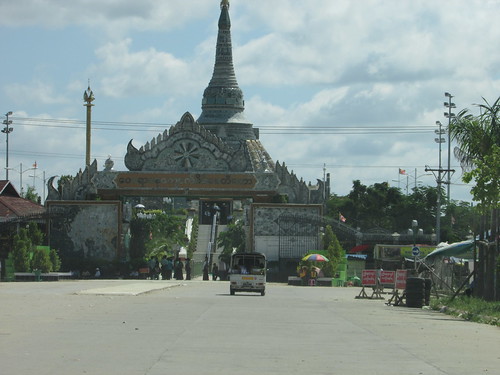
Mandalay district in 2017: The Jade Pagoda.
Ywa Taung is not far from Myitnge (although on the opposite side of the Ayeyarwaddy River). In 1975, Myanma Railways opened a diesel locomotive repair workshop there to supplement the capacity at Insein Works in Yangon. I was in Mandalay in 2015 as described here. I was unable to visit the works on that occasion because of an official holiday but visited the home of one of the managers and produced an article Ywa Taung Locomotive Workshop based on information I was given during that visit.
In 2017, I still didn't get to visit the works because the manager was away but I was able to make a social visit to his home.
It was agreed that I'd return to Mandalay by train from Ywa Taung station, allowing the car to take the family back to Myitnge but then my friend decided to accompany me on the train so he sent his family directly to Myitnge by car.
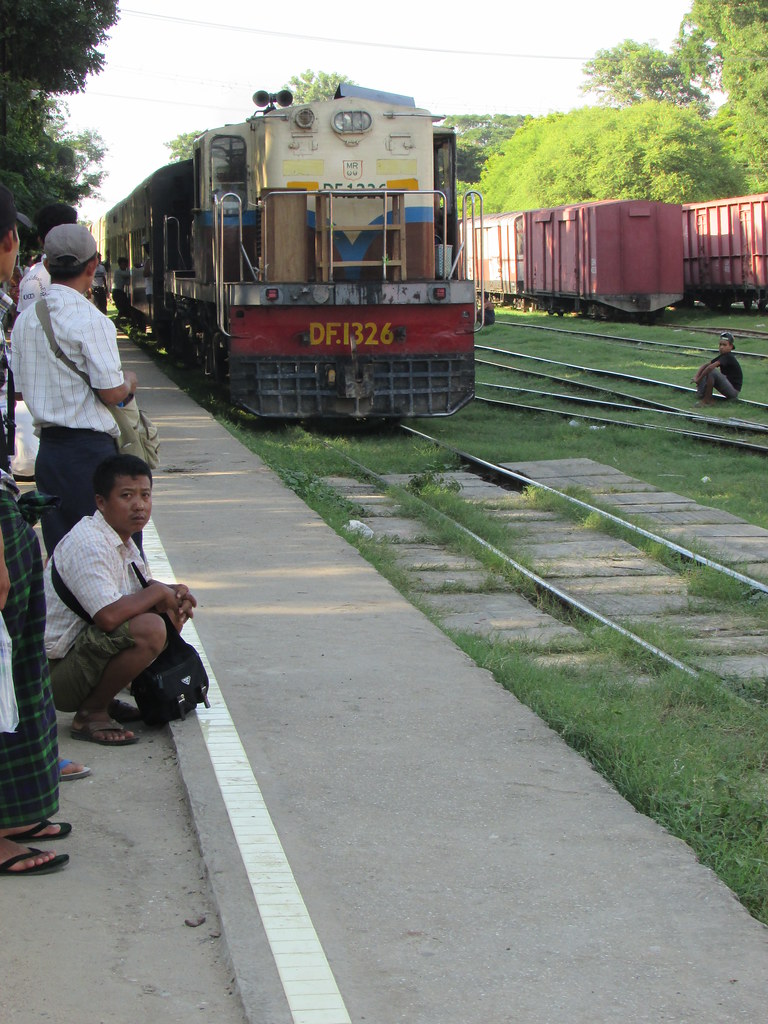
MR: Ywa Taung Station - DF.1326 arrives with the Up Myitkyina train on which I travelled to Mandalay.
After an interesting journey to Mandalay Station which took around an hour, we engaged two taxis - one to return my friend to Myitnge, a second to take me back to the Rupar Mandalar Hotel.
Related posts on this website
This is one of a series of posts describing my 12th visit to Myanmar. The post Starting out is the first post in the series.
Clicking on the 'Next report' link displays the post describing the next events. In this way, you may read about the trip in sequence.
Next report on this trip
Alternately, clicking on the 'All my Burma-2017(2) reports' link displays all the posts on this trip in reverse date-of-posting order.
All my Burma-2017(2) reports.
My photograph albums
Where necessary, clicking on an image above will display an 'uncropped' view or, alternately, pictures from may be selected, viewed or downloaded, in various sizes, from the albums listed:-
Rupar Mandalar Hotel.
MR: Myitnge Carriage and Wagon Workshop.
Family & Friends out & about.
Mandalay District.
MR: Ywa Taung - Mandalay.
[Amended 16-Oct-2017: Picture links added 17-Oct-2017: Minor edits, pictures added 08-Jan-2018]



















































